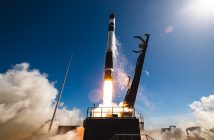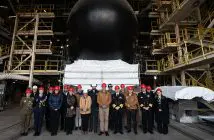
Asia’s Global Space and Technology Convention (GSTC) kicks off today, bringing together over 1,000 thought leaders, industry insiders and investors across 30 countries and regions, and is led by Singapore Space and Technology Limited (SSTL).
‘Future World. Endless Possibilities.’ – the theme for GSTC 2022 – sees the industry come together to ink partnerships, deepen cross-border collaborations and drive discussions on industry-shaping themes that will make space a key building block for the future – across economy, education and the planet.
The global space industry is estimated to reach US$1trn by 2040 and Asia is expected to be the fastest-growing region across multiple segments from spacecraft to small satellites.
Against this backdrop, it is timely that the industry is coming together to look at how space can accelerate economic recovery and growth; speed up innovation to tackle climate change and earth conversation challenges; and integrate space into education to prepare the talent pipeline for a world where space is ubiquitous.
“Super-charged connectivity and digitalisation brought on by COVID-19; COP26 cementing our global commitment to the planet and highlighting the importance of earth observation; increased innovation in space travel for civilians – these factors have all converged to boost the importance and relevance of the space industry to the economy, planet and even our future education agenda. It is time to double down on space with increased investments, high-impact collaborations and a fresh approach to talent development,” said Jonathan Hung, Chairman of Singapore Space and Technology Limited (SSTL).
Space startups are one of the most important pillars of innovation and one of the key announcements at GSTC 2022 is the launch by SSTL of Asia’s first dedicated commercial fund that will deploy investment into early-stage space and deep-tech startups.
SSTL runs the Space Accelerator Programme, which kicked off in 2020 with support by Enterprise Singapore (ESG). In under two years, the programme now supports 37 companies from 17 countries from Japan, India and Singapore to the US and Europe, across 5G connectivity, remote sensing technologies, cybersecurity for critical infrastructure and semi-autonomous space robots. The combined valuation of the companies stands at close to US$800 million, with a CAGR of over 60 per cent. A testament of the quality of the startups, over 38 per cent of the portfolio already receiving institutional investment.
“The new fund will help startups in the Space Accelerator Programme scale at warp speed, capitalising on the tremendous attention the industry is getting. In the same way that we have seen a lot of venture capital funds flooding into the technology space, we anticipate this will be mirrored in the space industry because of the heightened relevance and understanding of the sector,” said Jonathan Hung.
GSTC’s highlights this year include a dedicated pavilion hosting the most innovative space tech startups, discussions on space tech’s role in mobility and connectivity for the future by Kymeta and Singapore Land Authority (SLA); advances in cybersecurity by Block Armour; autonomous transportation developments by SLA, ST Engineering and Motional; and earth observation to avoid climate change by France’s National Centre for Space Studies.
Echoing the message of the impact of space across the economy, the planet and our future education agenda, several key MoUs (Memorandum of Understanding) and partnerships led by SSTL were inked at the conference.
Space for Our Future Economy
SSTL will ink three key MoUs that will strengthen its role as a space ecosystem builder to connect the industry across Asia and to connect Asia to the world.
SSTL will sign an MoU with UK Science and Technology Facilities Council (STFC) to facilitate a two-way deal flow of investment and trade between Singapore and UK-based space tech startups. The 360º agreement covers market access, test-bedding, market validation of opportunities, potential investment, research and capability-building.
SSTL will also ink an MoU with Volga-Dnepr Group to provide specialised logistics services for Asia’s space industry to further enhance SSTL’s range of services to support the space industry end-to-end.
SSTL will also continue its long-standing partnership with Singapore Land Authority with another MoU to accelerate the adoption of space and satellite technology through collaborations across industry and community. The two-pronged MoU with SLA will deepen innovation in satellite positioning, earth observation and related areas at the industry and community levels.
“To make space more ubiquitous means exponentially increasing the connection points within the space industry, between space and other industries, across borders and into our communities. These MoUs are significant because they touch on each of these strategic pillars that will help Asia take an important share of that anticipated US$1 trn industry potential,” said Lynette Tan, CEO of SSTL.
Space for Future Planet
SSTL and Changi Regional HADR Coordination Centre (RHCC) are launching Asia’s first feasibility study to leverage advanced space technology to predict natural disasters. In 2019, an estimated US$86.5 billion were lost to natural disasters in Southeast Asia. The joint study between SSTL and RHCC will go a long way towards stemming the heavy burden that natural disasters place on local economies.
GSTC 2022 is held from 9th – 10th February at Sheraton Towers Singapore.
Space Faculty Launch
Also launching today is Space Faculty, to develop the next generation of tech titans, entrepreneurs and technopreneurs. A spin-off from SSTL, its mandate is to develop learning and development pathways for individuals, organisations, governments and educational institutions, with space as a starting point.
Space is the ultimate innovation frontier to design for, and organisations are increasingly looking to this area for innovative solutions and technologies. Today, space already supports life on earth in a variety of ways, ranging from communications to GPS and weather forecasting. Moving forward, it will play an even greater role by influencing developments in Big Data, Internet of Things (IoT), predictive analytics and artificial intelligence (AI).
“One of the biggest gaps in the global innovation agenda today is the breadth of talent who can build for space today, innovate for deep tech tomorrow, and shape the global tech agenda for the future,” said Lynette Tan, Founder of Space Faculty and CEO of SSTL.
“Space will be the birthplace for the next tech titan, and we are here to build the runway for that by bringing together STEM, technopreneurship and leadership in a space-based learning context.”
Crafting a Learning and Development Blueprint for Space
Whether it is an organisation looking to strengthen its team’s expertise, gain access to talent or create bespoke learning and development programmes to cultivate an innovation mindset, Space Faculty can architect learning and development programmes for different ages, professions and goals.
With educational institutions facing the challenge of introducing space into the curriculum without a prior blueprint, Space Faculty offers a “faculty for hire” for end-to-end space curriculum development and delivery. Its dedicated experts will offer advice to institutions to integrate space learning into their classrooms, design the curriculum, and curate each institution’s very own space faculty.
At the end of the day, Space Faculty believes the next generation of tech titans will be those who start with space in mind – as their playground to test their innovative designs, a source of inspiration to create new solutions, and the new marketplace for ideas.
As a result, it has drawn up a roadmap for learning and development, to turn interest in space into a global career or the next deep-tech startup, for the five- to 95-year-old.
Nurturing the Next-Generation Tech Titan
To achieve these objectives and shape the future education agenda, Space Faculty introduced three critical initiatives, the first being its partnership with Amazon Web Services (AWS) to spearhead the introduction of space education and job opportunities for students of local Institutes of Higher Learning, helping them identify areas where their skills are demand in the space industry.
In partnership with OSTIn (Office for Space Technology and Industry, Singapore), Space Faculty will continue to amplify the International Space Challenge initiative that connects young minds across the globe with industry experts to nurture interest in space technology and its applications. The annual competition will create a runway for young space talent from 13 to 25 years.
Last but not least, Space Faculty will establish a partnership with Faith Methodist Preschool to launch Asia’s first space curriculum for early learners. Its preschoolers will be Singapore’s first batch of four- to seven-year-olds to learn about life on space and what it takes to pursue careers in deep tech and space.
“When I was little, the closest I got to a space dream was getting into a cardboard box and pretending it was a spaceship. I have the chance now to make that dream of going to space and learning about space a reality for the next generation by giving them a taste of the real thing, and bringing them as close to the stars as possible,” said Ms Tan.





